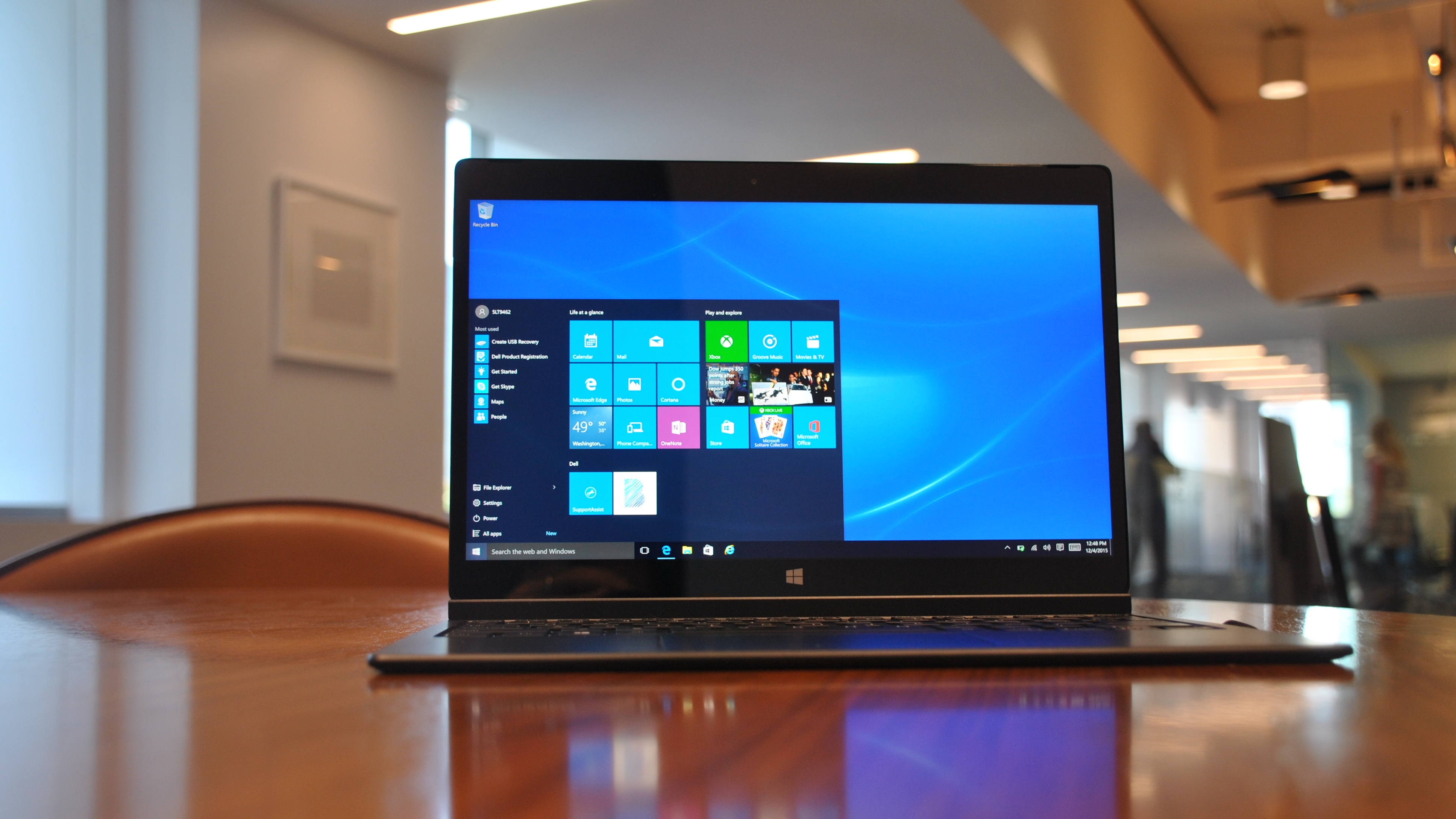Early Verdict
The Dell Latitude 7275 is attempting to compete with the best hybrids on the market. If it benchmarks well, there's no reason this device can't be your computer of choice for 2016.
Pros
- +
4K screen
- +
Light and thin
- +
Awesome folio
Cons
- -
Core M7-only
- -
USB-C-only
- -
No stylus included
Why you can trust TechRadar
If 2015 was the year of the hybrid laptop, then 2016 will be the year the hybrid laptop became mainstream. With the Microsoft Surface Pro 4, the Apple iPad Pro, the Google Pixel C, the HP Spectre x2 and the Lenovo IdeaPad Miix 700 on the market, there's no shortage of tablets that can latch onto a keyboard to help you stay productive.
With gorgeous business-class devices like the HP Elite x2 1012 hitting the market, even the enterprise is itching to get its hands on lightweight, attractive, powerful and thin 2-in-1s.
Not to be outdone by HP, Dell has introduced the Latitude 7275, a 12.5-inch 2-in-1 that's fantastic in almost every way.
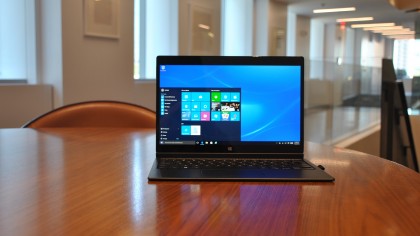
Design
The Latitude 7275 (starting at $1,049, about £714, AU$1,465) comes in two parts 1) a sleek, black, magnesium alloy tablet that weighs only 1.61 pounds (0.73kg) and measures just 0.32 inches tall (8.11mm) and 2) its accompanying slim keyboard – which features a fuzzy gray felt design that is delightful to touch and stare at. All in, the Latitude 7275 is about 0.67 inches (17.1mm) tall and 3.1 pounds (1.4kg) heavy.
As a laptop, the Latitude is about 0.17 inches thicker than the HP Elite x2 1012, 0.21 inches thicker than the Surface Pro 4, and 0.28 inches thicker than the iPad Pro. So you're not getting the thinnest 2-in-1 when you purchase this device, but you are getting a hybrid that is within the same weight class as the slimmest of the bunch.
It's also in the same class as these featherweights. The Elite x2 1012 weighs 2.72 pounds (1.23kg) when attached to its keyboard. The Surface Pro 4 weighs 2.37 pounds and the iPad Pro weighs 2.07 pounds when attached to their respective keyboards. So, the Latitude is again just outside of the best-in-class. As a standalone tablet, it is actually 0.24 pounds lighter than the Elite x2 1012 and about 0.08 pounds lighter than the Surface Pro 4. It is, however, 0.04 pounds heavier than the iPad Pro.
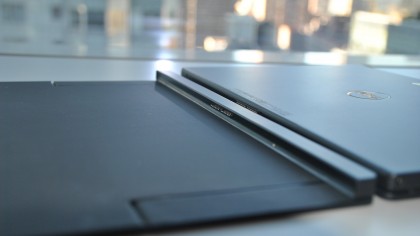
What separates the Latitude 7275 from the competition is its easy-to-attach magnetized keyboard attachment. With Dell's design, you simply line up 12 small POGO pins and, boom, the tablet slides easily onto the folio. There's no finagling, no jamming and no button-pressing. It's easy as pie.
Sign up to the TechRadar Pro newsletter to get all the top news, opinion, features and guidance your business needs to succeed!
The folio itself is pretty cool in that it can be adjusted to seat the tablet at anywhere from 100- to 130-degrees. This means you don't need to be sitting at the perfect angle to use the device on your lap – you can simply slide the folio backward or forward to get the exact viewing angle you'd like.
Design and video professionals will be excited to read that – unlike the Elite x2 1012, which only comes with a full HD resolution touchscreen – the Latitude 7275 comes with a UHD, or 4K, touchscreen option.
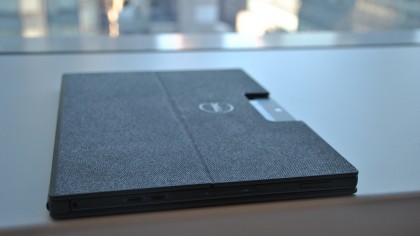
Configurations
Unfortunately, like so many of the Windows-based hybrids that are coming out these days, the Latitude 725 doesn't come with Intel's sixth generate Core i series of processors. This doesn't mean you're left with a junker. Dell lets you customize the tablet with up to Intel's Core M7 Skylake processor, just like the HP Elite.
This processor is perfectly-suited for anyone who doesn't do heavy video editing or graphic design work. In fact, based on benchmarking and anecdotal discussions among techradar staffers, a Core M7 provides a similar performance to the Core i5 processor.
If you absolutely need the top-of-the-line Core i7 processor, the Surface Pro 4 offers Core i7 configurations. As far as the iPad Pro is concerned, there has been a much-heated debate about whether or not Apple's tablet can function under heavy simultaneous workloads. The jury is still out, so the Surface is your safest bet today if you're using this for serious computing.
The Latitude can be configured with storage capacity starting at 128GB and maxing out at 512GB. All configurations come with 4 or 8GB of RAM and an Intel HD Graphics 515 card. This is exactly what you'll find on the Elite x2.
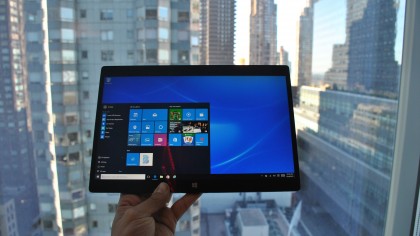
Unfortunately, Dell made the Latitude 7275 USB-C-only, so if you want to connect the device to USB 3.0, HDMI or Ethernet, you'll need to carry around a dongle or two, which is disappointing. The hybrid does feature 2 USB-C connectors so you'll be able to plug in a peripheral device while you're charging, which is a nice consolation. It also comes with an SD 4.0 Memory Card Reader and 1 micro SIM card slot for added storage needs.
The standard model of the 1012 comes with the travel keyboard, but no Active Stylus. That's unfortunate considering the Elite x2 comes with its own pen and keyboard. The iPad Pro's Smart Connector is a whopping $169 (£139, AU$269), and the Surface Pro 4 Type Cover is $129 (£85, AU$179). Like Dell, Apple makes you pay for its Stylus, ($99), so if you need the accessories, you should highly consider the Elite x2 1012.
The Latitude offers up to 10 hours of battery life, according to Dell. This is equivalent to the iPad Pro and Elite x2, but it's about 3 hours longer than the Surface Pro 4.
Early verdict
When you consider how similar the Latitude 7275 is designed compared to its rivals, it's hard not to get excited about this device. If it benchmarks well when we run our full review, you'll have a capable, long-lasting, stylish device that presents a nice business-class alternative to the more popular hybrids available.
The Latitude 7275 will likely be labeled a sure-fire competitor for 2016's best 2-in-1, especially if it benchmarks well. Although Dell's price tag is a bit on the high side, the Latitude 7275 is definitely a hybrid laptop you should keep your eye on.
The iPad Pro starts at $799 (£679, AU$1,249), but you're only getting 32GB of storage and you'll still have to buy the optional keyboard. Sure, it's lighter and slimmer, but do you really want to run iOS instead of Windows 10 for everyday productivity?
The entry-level Surface Pro 4 is outfitted almost exactly the same as the Latitude, albeit a bit slimmer and lighter, but you're going to wind up spending almost 1/5th the price of the tablet to add the Type Cover.
Until we can test the Latitude, there's no way of knowing how it will perform in comparison to competing devices. However, given its gorgeous design and its easy-to-use folio, you'll definitely want to play with this device yourself when it hits stores later this year.
What is a hands on review?
Hands on reviews' are a journalist's first impressions of a piece of kit based on spending some time with it. It may be just a few moments, or a few hours. The important thing is we have been able to play with it ourselves and can give you some sense of what it's like to use, even if it's only an embryonic view. For more information, see TechRadar's Reviews Guarantee.
